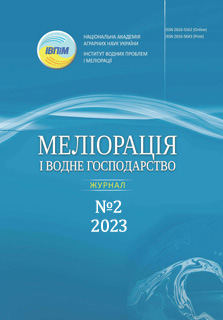NORMALIZED DIFFERENTIAL VEGETATION INDEX OF WINTER WHEAT DEPENDING ON THE RATES OF NITROGEN FERTILIZER AND NITRIFICATION INHIBITOR
Abstract
The article presents the results of experimental studies of the relationship between the normalized differential vegetation index and the yield of winter wheat at different rates of nitrogen fertilizers and the nitrification inhibitor 3,4-dimethylpyrazole phosphate with сarbamide-ammonia mixture (CAM-32). Field research was carried out in 2018-2021 in the research department of the Limited Liability Agricultural Company (LLAC) "Druzhba Nova" of the Varvyn district of the Chernihiv region (department of the «Kernel» agricultural holding). Analytical and mathematical and statistical methods were used to process experimental data. The normalized differential vegetation index (NDWI) was determined from the satellite images of WorldView-2, WorldView-3, Geoeye-1 (Maxar USA). The scheme of the one-factor field experiment was the use of options with different rates of nitrogen fertilizers (N100 and N120), as well as the use of the nitrification inhibitor 3,4-dimethylpyrazole phosphate in mixture to CAM-32. The control (backgroung) option was the application of fertilizers at the rate of N10P30K40. The results of experimental studies proved that NDWI is directly correlated with the yield of winter wheat for all 4 years of research. It was established that the NDWI, on average over three summer months, was higher in 2018 in the range of 0,56-0,67 and in 2020 – 0,53-0,66. The yield of winter wheat was also higher in 2018 and 2020, namely: in 2018 from 3,72 t/ha to 8,14 t/ha and in 2020 – from 3,77 t/ha to 7,25 t/ha. The NDWI, in 2019 and 2021, averaged over three summer months according to the experiment options was lower and amounted to 0,33-0,38 in 2019, and 0,30-0,33 in 2021. This trend correlates with winter wheat yields, which were also low during this period. So, in 2019 it was 3,63 t/ha – 5,10 t/ha and in 2021 – 3,83–4,81 t/ha. The correlation coefficient between NDWI and the yield of winter wheat was high: in July and August, it was from 0,93 to 0,97 on the options with nitrogen fertilizer rates N100 and N120.
References
2. Gitelson, A.A., Kaufman, Y.J., & Merzlyak, M.N. (1996). Use of a green channel in remote sensing of global vegetation from EOS-MODIS. Remote Sensing of Environment, 58 (3), 289-298.
3. Pettorelli, N., Vik, J.O., Mysterud, A., Gaillard, J.M., Tucker, C.J., & Stenseth, N.C. (2005). Using the satellite-derived NDVI to assess ecological responses to environmental change. Trends in Ecology & Evolution, 20 (9), 503-510.
4. Jiang, Z., & Huete, A.R. (2006). Global intercomparison of three NDVI datasets for 1981–2001. Remote Sensing of Environment, 101(2), 366-379.
5. Hatfield, J.L., Gitelson, A.A., Schepers, J.S., & Walthall, C.L. (2008). Application of spectral remote sensing for agronomic decisions. Agronomy Journal, 100(1), 121-127.
6. Tucker, C.J. (1979). Red and photographic infrared linear combinations for monitoring vegetation. Rem. Sens. Environ. 8 (2), 127–150. https://doi.org/10.1016/0034- 4257(79)90013-0
7. Myneni, R.B., Hall, F.G., Sellers, P.J., & Marshak, A.L. (1995). The interpretation of spectral vegetation indexes. IEEE Transactions on Geoscience and Remote Sensing, 33 (2), 481-486.
8. Vrieling, A., De Leeuw, J., & Said, M.Y. (2013). Length of growing period over Africa: variability and trends from 30 years of NDVI time series. Rem. Sens. 5 (2), 982–1000. https://doi.org/10.3390/rs5020982
9. Zhu, Z., Bi, J., Pan, Y., Ganguly, S., Anav, A., Xu, L., Samanta, A., Piao, S., Nemani, R.R., & Myneni, R.B. (2013). Global data sets of vegetation leaf area index (LAI) 3g and fraction of photosynthetically active radiation (FPAR) 3g derived from global inventory modeling and mapping studies (GIMMS) normalized difference vegetation index (NDVI3g) for the period 1981 to 2011. Rem. Sens. 5 (2), 927–948. https://doi. org/10.3390/rs5020927
10. Eid, A.N.M., Olatubara, C.O., Ewemoje, T.A., Farouk, H., & El-Hennawy, M.T. (2020). Coastal wetland vegetation feature and digital change detection mapping based on remotely sensed imagery: El-Burullus Lake Egypt. Int. Soil Water Conserv. Res. 8 (1), 66–79. https://doi.org/10.1016/j.iswcr.2020.01.004
11. Darby, F.A., & Turner, R.E. (2008). Below- and aboveground Spartina alterniflora production in a Louisiana salt marsh. Estuar. Coast 31, 223–231. https://doi.org/ 10.1007/s12237-007-9014-7.
12. Justice, C.O., Townshend, J.R., Holben, B.N., & Tucker, C.J. (1985). Analysis of the phenology of global vegetation using meteorological satellite data. International Journal of Remote Sensing, 6 (8), 1271-1318
13. Ozesmi, S.L., & Bauer, M.E. (2002). Satellite remote sensing of wetlands. Wetl. Ecol. Manag. 10 (5), 381–402. https://doi.org/10.1023/a:1020908432489
14. Ghosh, S., Mishra, D.R., & Gitelson, A.A. (2016). Long-term monitoring of biophysical characteristics of tidal wetlands in the northern Gulf of Mexico - a methodological approach using MODIS. Rem. Sens. Environ. 173, 39–58. https://doi.org/10.1016/j. rse.2015.11.015
15. Greben', A.S., & Krasovskaya, I.G. (2012). Analiz osnovnykh metodik prognozirovaniya urozhajnosti s pomoshch'yu dannykh kosmicheskogo monitoringa, primenitel'no k zernovym kul'turam stepnoj zony Ukrainy. [Analysis of the main methods of yield forecasting with the help of space monitoring data, as applied to cereal crops of the steppe zone of Ukraine]. Radioelektronni i kompiuterni systemy, 2 (54), 170-180. [In Russian].
16. Wardlow, B.D., & Egbert, S.L. (2008). Large-area crop mapping using time-series MODIS 250 m NDVI data: An assessment for the U.S. Central Great Plains. Remote Sensing of Environment, 112 (3), 1096-1116.
17. Hansen, P.M., & Schjoerring, J.K. (2003). Reflectance measurement of canopy biomass and nitrogen status in wheat crops using normalized difference vegetation indices and partial least squares regression. Remote Sensing of Environment, 86 (4), 542-553.
18. Semenova, I.H. (2014). Vykorystannia vehetatsiinykh indeksiv dlia monitorynhu posukh v Ukraini. [The use of vegetation indices for drought monitoring in Ukraine]. Ukrainskyi hidrometeorolohichnyi zhurnal, 14, 43-52. [In Ukrainian].
19. Tarariko, O.H., Syrotenko, O.V., Ilienko, T.V., & Kuchma, T.L. (2019). Ahroekolohichnyi suputnykovyi monitorynh [Agroecological satellite monitoring]. Kyiv, 135-158. [In Ukrainian].
20. European Parliament and of the Council. (2014). Commission Regulation (EU) № 1257/2014 amending Regulation (EC) No. 2003/2003 of the European Parliament and of the Council relating to fertilizers for the purposes of adapting Annexes I and IV., 12.


